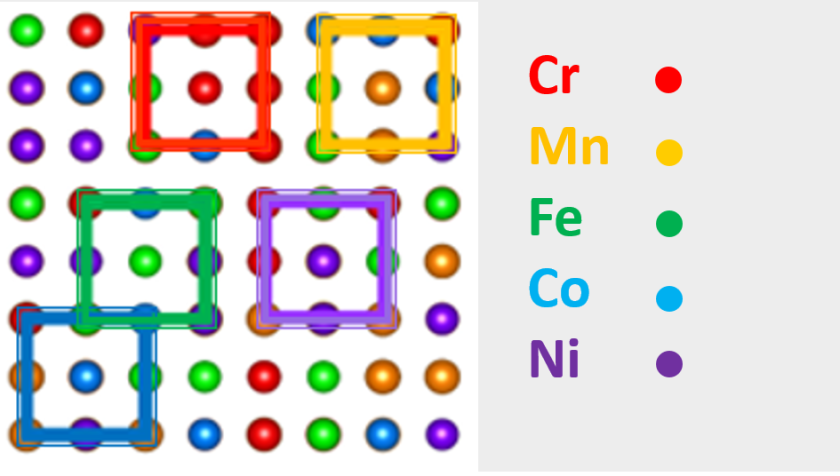BESSY II: Local variations in the structure of High-Entropy Alloys

The analysis of the EXAFS data showed different local environments around the elements of the Cantor alloy depending on the annealing temperature, which indicate different ordering and diffusion processes. Manganese diffuses fastest in the high-temperature state, nickel in the low-temperature state. © HZB
High-entropy alloys can withstand extreme heat and stress, making them suitable for a variety of specific applications. A new study at the X-ray synchrotron radiation source BESSY II has now provided deeper insights into the ordering processes and diffusion phenomena in these materials. The study involved teams from HZB, the Federal Institute for Materials Research and Testing, the University of Latvia and the University of Münster.
The team analysed samples of a so-called Cantor alloy, which consists of five 3d elements: chromium, manganese, iron, cobalt and nickel. The samples of crystalline structures (face-centred cubic, fcc) were annealed at two different temperatures and then shock frozen.
The study focussed on unravelling local atomic structures in single crystalline samples cooled from either a high-temperature (HT) state annealed at 1373 Kelvin or a low-temperature (LT) state annealed at 993 Kelvin. To analyse the local environments of the individual elements in the samples, the team used a well established method: element-specific multi-edge X-ray absorption spectroscopy (EXAFS). To interpret the measurement data in the most precise and unbiased manner, the team carried out a Reverse Monte Carlo (RMC) based analysis.
"In this way, we have been able to reveal, both qualitatively and quantitatively, the peculiarities of the characteristic local environments of each principal components of the alloy at the atomic scale," explains Dr Alevtina Smekhova from HZB. In particular, the spectroscopic results also provide insights into the diffusion processes in HEAs. For example, it was directly demonstrated that the element manganese diffuses fastest in the HT samples, while the element nickel diffuses faster in the LT samples as it was found earlier from diffusion experiments.
"These results help us to better understand the relationship between the local atomic environment and the macroscopic properties in these alloys," explains Smekhova.
arö
https://www.helmholtz-berlin.de/pubbin/news_seite?nid=26126;sprache=en
- Copy link
-
The future of corals – what X-rays can tell us
This summer, it was all over the media. Driven by the climate crisis, the oceans have now also passed a critical point, the absorption of CO
2 is making the oceans increasingly acidic. The shells of certain sea snails are already showing the first signs of damage. But also the skeleton structures of coral reefs are deteriorating in more acidic conditions. This is especially concerning given that corals are already suffering from marine heatwaves and pollution, which are leading to bleaching and finally to the death of entire reefs worldwide. But how exactly does ocean acidification affect reef structures?
Prof. Dr. Tali Mass, a marine biologist from the University of Haifa, Israel, is an expert on stony corals. Together with Prof. Dr. Paul Zaslansky, X-ray imaging expert from Charité Berlin, she investigated at BESSY II the skeleton formation in baby corals, raised under different pH conditions. Antonia Rötger spoke online with the two experts about the results of their recent study and the future of coral reefs.
-
Susanne Nies appointed to EU advisory group on Green Deal
Dr. Susanne Nies heads the Green Deal Ukraina project at HZB, which aims to support the development of a sustainable energy system in Ukraine. The energy expert has now also been appointed to the European Commission's scientific advisory group to comment on regulatory burdens in connection with the net-zero target (DG GROW).
-
Long-term stability for perovskite solar cells: a big step forward
Perovskite solar cells are inexpensive to produce and generate a high amount of electric power per surface area. However, they are not yet stable enough, losing efficiency more rapidly than the silicon market standard. Now, an international team led by Prof. Dr. Antonio Abate has dramatically increased their stability by applying a novel coating to the interface between the surface of the perovskite and the top contact layer. This has even boosted efficiency to almost 27%, which represents the state-of-the-art. After 1,200 hours of continuous operation under standard illumination, no decrease in efficiency was observed. The study involved research teams from China, Italy, Switzerland and Germany and has been published in Nature Photonics.
